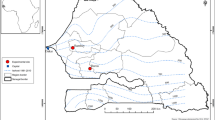Abstract
Cardamom is an important high value spice crop. Hybrid breeding is discussed for some time, but there is no information for cardamom. Eight genetically diverse cardamom lines were crossed in a diallel to evaluate the performance of hybrids and determine heterosis over mid-parent, better-parent and standard control for yield and yield components. The study was undertaken for a period of 3 years from 1988 to 2001 (Experiment I). Hybrids generally showed good overall performance for most of the characteristics compared with parents. Ten of the 56 hybrids significantly out-yielded the standard control (RR 1). Substantial mid-parent (MPH), better-parent (BPH) and standard (SH) heterosis were observed for the majority of the characteristics studied. Further evaluation of selected hybrids for yield and disease resistance during 2002–2007 (Experiment II) led to the identification of two cross combinations (CCS 1 × NKE 19 and RR 1 × NKE 12) with high yield and mosaic resistance. The study revealed that cardamom hybrids with high yield potential, desirable quality characteristics and mosaic resistance can be developed from appropriate parents through heterosis breeding. This is the first report of heterosis in cardamom for yield and yield contributing characteristics.

Similar content being viewed by others
References
American Spice Trade Association (ASTA) (1997) Official analytical methods, vol 4. American Spice Trade Association, New York
Anonymous (2008) Area and production statistics of arecanut and spices. Directorate of arecanut and spices development. Ministry of Agriculture, Government of India, Calicut, Kerala, India, p 62
Duvick DN (1999) Heterosis: feeding people and protecting natural resources. In: Coors JG, Pandey S (eds) Genetica and exploitation of heterosis in crops. ASA, CSSA and SSSA, Madison, pp 19–29
Falconer DS, Mackay TFC (1996) Introduction to quantitative genetics, 4th edn. Longman, New York
Gowen JW (1952) Heterosis. Iowa State College, Ames
Johnson R, Lupton FGH (1987) Breeding for disease resistance. In: Lupton FG (ed) Wheat breeding, its scientific basis. Chapman & Hall, London, New York, pp 403–406
Jordaan JP (1999) Breeding hybrid wheat for low-yielding environments. In: Satorre EH, Slafer GA (eds) Wheat: ecology and physiology of yield determination. Food Products Press/Haworth Press, New York, pp 417–439
Knobel HA, Labuschange MT, Van Deventer CS (1997) The expression of heterosis in the F1 generation of a diallel cross of diverse hard red winter wheat genotypes. Cereals Res Commun 25:911–915
Krishnamurthy K, Khan MM, Avadhani KK, Venkatesh J, Siddaramaiah AL, Chakravarthy AK, Gurumurthy SR (1989) Three decades of cardamom research at regional research station, Mudigere (1958–1988), Technical bulletin No. 2. Regional Research Station, Mudigere Karnataka, India
Kuroda S, Kato H, Ikeda R (1998) Heterosis and combining ability for callus growth rate in rice. Crop Sci 33:933–936
Kuruvilla KM, Madhusoodanan KJ, Vadivel V, Radhakrishnan VV, Patil VV, Thomas J (2006) Hybrid cardamom ‘MHC-26’ with high yield and quality capsule traits. J Plant Crops 34(3):208–211
Lamkey KR, Edwards JW (1999) Quantitative genetics of heterosis. In: Coors JG, Pandey S (eds) Genetica and exploitation of heterosis in crops. ASA, CSSA and SSSA, Madison, pp 31–48
Madhusoodanan KJ, Radhakrishnan VV, Kuruvilla KM (1999) Genetic resources and diversity in cardamom. In: Sasikumar B, Krishnamoorthy B, Rema J, Ravindran PN, Peter KV (eds) Biodiversity conservation & utilization of spices medicinal and aromatic plants. Indian Society for Spices, Calicut, Kerala, India, pp 68–72
Morgan CL, Austin RB, Ford MA, Bingham J, Angus WJ, Chowdhury S (1989) An evaluation of F1 hybrid winter wheat genotypes produced using a chemical hybridizing agent. J Agric Sci Camb 112:143–149
Padmini K, Venugopal MN, Sasikumar B (2000) Performance of hybrids, open pollinated progenies and inbreds of cardamom (E. cardamomum) under nursery conditions. Indian J Agric Sci 70:550–551
Padmini K, Venugopal MN, Ankegowda SJ (2001) Heterosis for seedling characters in cardamom (Elettaria cardamomum Maton.). J Spices Aromat Crops 9(2):145–151
Purseglove JW, Brown EG, Green CL, Robbins SRJ (1981) Spices, vol 2, Longman Inc., New York, USA
Sarath Kumara SJ, Packiyasothy EV, Jansz ER (1985) Some studies on the effect of maturity and storage on the chlorophyll content and essential oils of the cardamon fruit (Elettaria cardamomum). J Sci Food Agric 36(6):491–498. doi:10.1002/jsfa.2740360611
Snedecor GW, Cockhran CWG (1967) Statistical methods. The Iowa State University Press, Iowa
Sreekrishna Bhat S, Sudharshan MR (2006) Evaluation of cardamom genotypes in Karnataka for yield and quality. J Plant Crops 34(3):212–215
Statsoft (1997) Statistica for Windows, version 5.1. Statsoft, Tulsa
Venugopal MN (1999) Natural disease escapes as source of resistance against cardamom mosaic virus causing katte disease of cardamom (Elettaria cardamomum Maton). J Spices Aromat Crops 8:145–151
Venugopal MN (2002) Viral diseases. In: Ravindran PN, Madhusoodanana KJ (eds) Cardamom—the genus Elettaria. Taylor & Francis, London, pp 143–159
Venugopal MN, Prasath D (2003) Cardamom (Elettaria cardamomum Maton.)—varietal status. Green Technol 5:14–17
Venugopal MN, Ankegowda SJ, Prasath D (2006) Cardamom. In: Major spices—production and processing. Indian Institute of Spices Research, Calicut, pp 62–114
Young J, Virmani SS (1990) Heterosis in rice over environments. Euphytica 51:87–93. doi:10.1007/BF00022896
Author information
Authors and Affiliations
Corresponding author
Rights and permissions
About this article
Cite this article
Prasath, D., Venugopal, M.N., Senthilkumar, R. et al. Hybrid performance for yield and yield components in cardamom (Elettaria cardamom Maton). Euphytica 168, 49–60 (2009). https://doi.org/10.1007/s10681-008-9878-z
Received:
Accepted:
Published:
Issue Date:
DOI: https://doi.org/10.1007/s10681-008-9878-z




